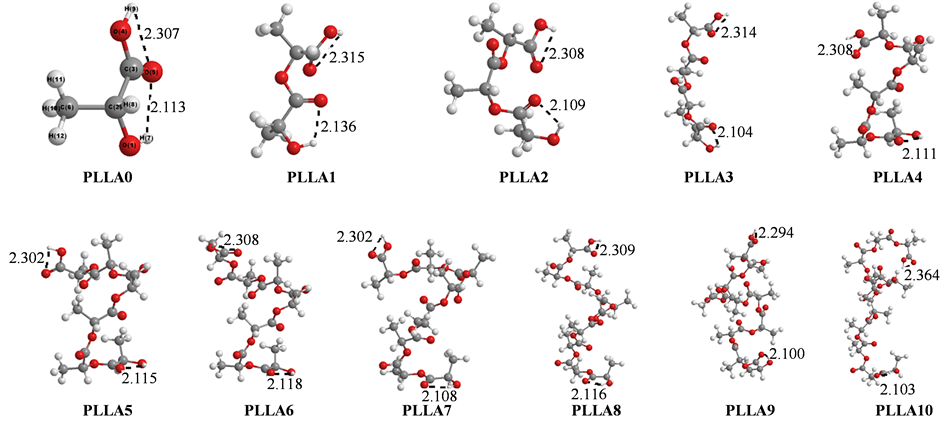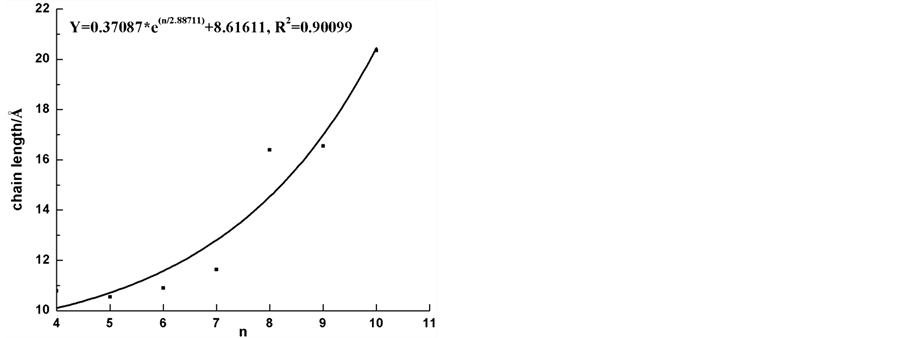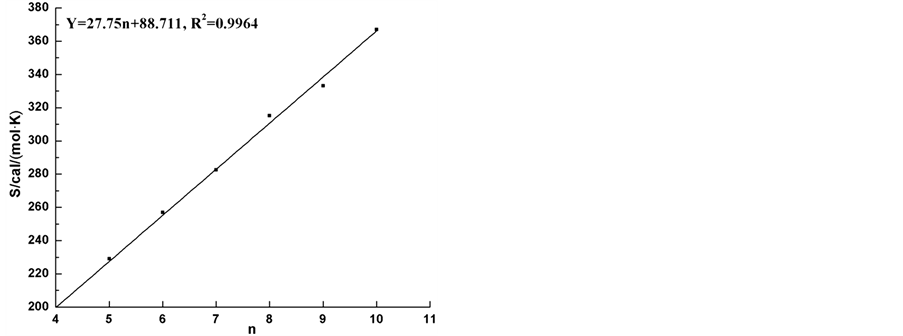Journal of Advances in Physical Chemistry
Vol.04 No.03(2015), Article ID:15806,7 pages
10.12677/JAPC.2015.43012
Computational Study on the L-Lactic Acid Oligomers in α-Helix
Minmin Zhang1, Qin Jin2, Rui Hang1, Diqin Zeng1, Wu Zheng1, Yanan Xue1, Biru He1, Chaojie Wang2
1Information and Engineering School, Wenzhou Medical University, Wenzhou Zhejiang
2School of Pharmaceutical Science, Wenzhou Medical University, Wenzhou Zhejiang
Email: 1161132682@qq.com, chjwang@wmu.edu.cn
Received: Jul. 20th, 2015; accepted: Aug. 2nd, 2015; published: Aug. 5th, 2015
Copyright © 2015 by authors and Hans Publishers Inc.
This work is licensed under the Creative Commons Attribution International License (CC BY).
http://creativecommons.org/licenses/by/4.0/



ABSTRACT
The geometrical structures, thermodynamics, spectral property and the conceptual
density functional analysis of L-lactic acid oligomers in α-helix were calculated
at CAM-B3LYP/6-311+G* level in gas phase. The chain length of PLLAn and the degree
of polymerization obey the equation: .
The results showed that three types of intramolecular hydrogen bonds were beneficial
to form the L-lactic acid oligomers in α-helix. The values of thermodynamics showed
linear correlation of entropy (S) of PLLAn and the degree of polymerization:
.
The results showed that three types of intramolecular hydrogen bonds were beneficial
to form the L-lactic acid oligomers in α-helix. The values of thermodynamics showed
linear correlation of entropy (S) of PLLAn and the degree of polymerization: . Compared with
the experimental values, the stretching vibrational frequencies of the C=O, COO-H
and O-H bonds exhibit a general blue shift. Among all of the structures, the electrophilicity
indexes of PLLA7 are the smallest, but its acidity is the strongest.
. Compared with
the experimental values, the stretching vibrational frequencies of the C=O, COO-H
and O-H bonds exhibit a general blue shift. Among all of the structures, the electrophilicity
indexes of PLLA7 are the smallest, but its acidity is the strongest.
Keywords:PLLA, CAM-B3LYP, Degree of Polymerization, Hydrogen Bond

α-螺旋型寡聚L-乳酸的计算研究
张敏敏1,金芩2,杭睿1,曾狄勤1,郑武1,薛雅楠1,何碧如1,王朝杰2
1温州医科大学信息与工程学院,浙江 温州
2温州医科大学药学院,浙江 温州
Email: 1161132682@qq.com, chjwang@wmu.edu.cn
收稿日期:2015年7月20日;录用日期:2015年8月2日;发布日期:2015年8月5日

摘 要
在CAM-B3LYP/6-311+G*水平,对气相中α-螺旋型寡聚L-乳酸的几何结构、热力学性质和谱学性质进行了详细的计算研究,并根据概念密度泛函理论对各稳定结构的化学性质进行考察。链长与聚合度满足拟合方程: 。寡聚L-乳酸通过三种氢键形成螺旋状寡聚物。热力学数据显示,熵值与聚合度呈较好线性相关,其拟合方程为
。寡聚L-乳酸通过三种氢键形成螺旋状寡聚物。热力学数据显示,熵值与聚合度呈较好线性相关,其拟合方程为 。计算得到的各结构中C=O、COO-H和O-H键的伸缩振动频率与实验值相比,发生蓝移。PLLA7的亲电指数最小,酸性最强。
。计算得到的各结构中C=O、COO-H和O-H键的伸缩振动频率与实验值相比,发生蓝移。PLLA7的亲电指数最小,酸性最强。
关键词 :寡聚L-乳酸,CAM-B3LYP,聚合度,氢键

1. 引言
聚乳酸(Polylactic acid, PLA)是一类研究和应用最为广泛的生物大分子材料[1] [2] ,通过分子内氢键 [3] 的作用形成特殊的大分子结构,表现其独特的性能,从而更好地满足生物医学领域对高分子材料性能的要求。研究丙交酯作为聚乳酸中间体,有3种立体异构体,由其开环聚合得到的聚乳酸有多种链结构,如聚L-乳酸(PLLA)、聚D-乳酸(PDLA)和聚D,L-乳酸(PDLLA)等。Dong等 [4] 通过差示扫描量热法等方法对PLA的性能做了详细考察。Winter等 [5] 从实验和理论水平研究了钠离子聚乳酸聚合物的性质。国内外对聚乳酸的结构、合成和降解等方面进行了详细研究 [6] - [12] 。理论工作者也开展了关于聚乳酸的研究工作。易隽 [13] 采用Monte Carlo方法从分子水平模拟研究了聚乳酸的降解过程。吴雁等 [14] 通过计算机研究了L-丙交酯和D,L-丙交酯共聚物立体化学构型。Lin团队 [15] [16] 采用PW91方法计算了聚乳酸的α-、β-、γ-和sc-四种晶相,复合sc-构型在分子间氢键的作用下,在热力学上更稳定,与此同时探究了其结构和电子性质。本文采用密度泛函理论方法计算了螺旋状PLLA的结构、热力学和谱学性质,从分子水平研究聚L-乳酸的性质。
2. 计算方法
本文在CAM-B3LYP/6-311+G*水平对螺旋状PLLA进行结构优化和性质计算。该方法在计算电离能、电子亲和能和超极化率等方面,较传统密度泛函理论方法更优 [17] 。为深入理解分子化学性质,又考察了其电负性和硬度与聚合度的关系。所有计算均使用Guassian 09程序包 [18] 完成。
3. 结果与讨论
3.1. 几何结构
图1绘制了计算得到的以L-乳酸为单体的寡聚L-乳酸稳定结构,各结构按照聚合度(n)命名为PLLAn (n = 0~10)。各结构原子标示见PLLA0,并在图中标明了分子内氢键的距离,单位为Å。按照随着聚合度的增大,当n ≥ 4时,PLLAn在分子内氢键的作用下,形成α-螺旋型结构。Irsai等 [19] 采用分子力学法、半经验法、从头算方法和DFT方法,参照蛋白质的α-螺旋型和β-片层型二级结构,只计算了聚合度

Figure 1. Geometrical structures of PLLA in α-helix calculated at CAM-B3LYP/6-311+G* level
图1. 在CAM-B3LYP/6-311+G*水平计算得到的α-螺旋型寡聚L-乳酸的几何结构
为9的寡聚乳酸的二级结构,其中DFT方法计算的结果更精确。本文采用DFT方法详细考察了聚合度从0到10寡聚乳酸的结构和性质,发现链长与聚合度之间服从拟合方程:

见图2。计算得到的PLLA9的链长值与文献 [19] 中B3LYP/6-31G*水平计算的13.3 Å相比,长6.0 Å左右。各结构中出现三种弱相互作用,一是羰基氧与主链上的氢作用,形成C=O…H-CR;另一种是羰基氧与甲基的氢作用,形成C=O…H-CH2R;还有一种是羧基内形成氢键C=O…O-H。图中羧基内氢键约2.310 Å,而其他类型的则为2.110 Å左右。与文献 [20] 在B3LYP/6-311++G**水平计算的真空环境乳酸甲酯中有一个距离为2.58 Å的C=O…O-H相比,距离更短。
3.2. 热力学特征
表1列出了CAM-B3LYP/6-311+G*水平计算得到的PLLAn (n = 0~10)的能量数据,电子总能量E是考虑了零点振动能(ZPVE)校正的数值,其中能量值和前线轨道能差(Δε)计算由下式给出:

其中E分别为不同构象的电子总能量E、内能∆U、焓∆H和吉布斯自由能∆G。由能量学数据可知,形成螺旋结构较稳定的是PLLA4、PLLA5、PLLA6和PLLA8,其∆E值在4.24
kJ∙mol−1左右,PLLA7和PLLA9的值较大,稳定性相对也较差。图3绘制了熵值S和聚合度的关系,服从拟合方程:  图4绘制了的PLLAn
(n = 4~10)的能隙图,其前线轨道能差均在10.00 eV左右。
图4绘制了的PLLAn
(n = 4~10)的能隙图,其前线轨道能差均在10.00 eV左右。
3.3. 谱学性质对优化得到的稳定螺旋结构进行谱学性质的研究,得到的C=O、COO-H和O-H键的伸缩振动频率值详细列于表2。文献 [19] 在B3LYP/6-31G*水平计算得到D-乳酸III的C=O伸缩振动发生在1755.0 cm−1

Figure 2. The curve between the chain length of PLLA in α-helix and the degree of polymerization
图2. α-螺旋型寡聚L-乳酸的链长与聚合度的曲线

Figure 3. The curve between the values of entropy (S) of PLLA in α-helix and the degree of polymerization
图3. α-螺旋型寡聚L-乳酸的熵值与聚合度的曲线

Figure 4. The energy gap of PLLA in α-helix calculated at CAM-B3LYP/6-311+G* level
图4. 在CAM-B3LYP/6-311+G*水平计算得到的α-螺旋型寡聚L-乳酸的能隙
表1. 在CAM-B3LYP/6-311+G*水平计算得到的α-螺旋型寡聚L-乳酸的能量值
表2. α-螺旋型寡聚L-乳酸的C=O、COO-H与O-H键的伸缩振动频率
处;PLLA的α-、β-和γ-三种晶相聚乳酸在1750.0~1800.0 cm−1处表现为C=O伸缩振动。文献 [11] 中傅里叶红外光谱数据显示在1750.0~1800.0 cm−1有一个尖峰,对应C=O伸缩振动。文献 [21] 测得的红外光谱图显示,3300~3400 cm−1出现由羟基和参与氢键形成的羟基引起的叠加峰。与文献值相比,C=O伸缩振动蓝移约100.0 cm−1,COO-H和O-H键的伸缩振动频率也发生蓝移400.0 cm−1左右。图5绘制了各稳定结构转动系数(A、B和C)随聚合度的变化情况,得到对应的拟合方程:




Figure 5. The curve between the rotational constants (A, B and C) of PLLA in α-helix and the degree of polymerization
图5. α-螺旋型寡聚L-乳酸的转动系数值A、B和C与聚合度的曲线
Table 3. The values of electronegativity (χ), hardness (η), softness (S) and electrophilic index (ω) of PLLA in α-helix
表3. α-螺旋型寡聚L-乳酸的电负性(χ)、硬度(η)、软度(S)和亲电指数(ω)
3.4. 电负性和硬度
为了进一步与探讨螺旋型寡聚结构的化学性质,根据概念密度泛函理论,按照下式计算了PLLAn (n = 0~10)的电负性(χ)、硬度(η)、软度(S)和亲电指数(ω) [17] :




具体数值见表3。PLLA0、PLLA1、PLLA9和PLLA10的电负性较大,得电子能力越强,其羧基上的H+解离能力越弱,表现出来的酸性也相应较弱。由η值可知,游离的L-乳酸的硬度值较寡聚乳酸大。PLLA7的亲电指数最小,亲电性最弱,则其对应的酸性则是最强的。
4. 结论
采用长程校正密度泛函理论方法CAM-B3LYP,在6-311+G*水平计算得到以L-乳酸为单体的α-螺旋型寡聚L-乳酸PLLAn (n = 0~10)。各结构通过三种弱相互作用,羰基氧与主链上的氢作用形成的C=O…H-CR、羰基氧与甲基的氢作用形成的C=O…H-CH2R和羧基内氢键C=O…O-H,形成稳定螺旋结构。且发现链长与聚合度之间存在指数函数关系。能量学数据显示:较稳定的螺旋结构是PLLA4、PLLA5、PLLA6和PLLA8,且熵值与聚合度呈线性相关。PLLAn (n = 0~10)的C=O、COO-H和O-H键的伸缩振动频率与文献相比,发生蓝移。根据概念密度泛函理论可知,PLLA7的酸性最强。
致谢
感谢浙江省大学生科技创新活动计划(新苗人才计划)项目(2013R413014)的资助。
文章引用
张敏敏,金 芩,杭 睿,曾狄勤,郑 武,薛雅楠,何碧如,王朝杰, (2015) α-螺旋型寡聚L-乳酸的计算研究
Computational Study on the L-Lactic Acid Oligomers in α-Helix. 物理化学进展,03,103-110.
doi:
10.12677/JAPC.2015.43012
参考文献 (References)
- 1. Bishai, M., De, S., Adhikari, B. and Banerjee, R. (2014) A comprehensive study on enhanced characteristics of modified polylactic acid based versatile biopolymer. European Polymer Journal, 54, 52-61. http://dx.doi.org/10.1016/j.eurpolymj.2014.01.027
- 2. Munteanu, B.S., Aytac, Z., Pricope, G.M., Uyar, T. and Vasile, C. (2014) Polylactic acid (PLA)/silver-NP/VitaminE bionanocomposite electrospun nanofibers with antibacterial and antioxidant activity. Journal of Nanoparticle Research, 16, 2643. http://dx.doi.org/10.1007/s11051-014-2643-4
- 3. 周光耀 (2015) 氢键的量子化学研究(一). 物理化学进展, 4, 84-101.
- 4. Dong, Y., Ghataura, A., Takagi, H., Haroosh, H.J., Nakagaito, A.N. and Lau, K.T. (2014) Polylactic acid (PLA) biocomposites reinforced with coir fibres: Evaluation of mechanical performance and multifunctional properties. Composites: Part A, 63, 76-84. http://dx.doi.org/10.1016/j.compositesa.2014.04.003
- 5. Winter, J.D., Lemaur, V., Marsal, P., Coulembier, O., Cornil, J., Dubois, P. and Gerbauxa, P. (2010) Mechanistic study of the collision-induced dissociation of sodium-cationized polylactide oligomers: A joint experimental and theoretical investigation. Journal of the American Society for Mass Spectrometry, 21, 1159-1168. http://dx.doi.org/10.1016/j.jasms.2010.03.026
- 6. 翁云宣 (2007) 聚乳酸合成、生产、加工及应用研究综述. 塑料工业, 35, 69-73.
- 7. 战玥 (2013) 聚乳酸(PLA)生物循环降解的研究. 硕士论文, 东北师范大学, 长春.
- 8. 赵申 (2005) 聚乳酸多嵌段共聚物的合成及表征. 硕士论文, 浙江大学, 杭州.
- 9. Jacobs, T., Declercq, H., Geyter, N.D., Cornelissen, R., Dubruel, P., Leys, C., Beaurain, A., Payen, E. and Morent, R. (2013) Plasma surface modification of polylactic acid to promote interaction with fibroblasts. Journal of Materials Science-Materials in Me-dicinem, 24, 469-478. http://dx.doi.org/10.1007/s10856-012-4807-z
- 10. Gao, Q., Lan, P., Shao, H. and Hu, X.C. (2002) Direct synthesis with melt polycondensation and microstructure analysis of poly(L-lactic acid-co-glycolic acid). Polymer Journal, 34, 786-793. http://dx.doi.org/10.1295/polymj.34.786
- 11. Rychlý, J., Rychlá, L., Stloukal, P., Koutný, M., Pekařová, S., Verney, V. and Fiedlerová, A. (2013) UV initiated oxidation and chemiluminescence from aromatic-aliphatic co-polyesters and polylactic acid. Polymer Degradation and Stability, 98, 2556-2563. http://dx.doi.org/10.1016/j.polymdegradstab.2013.09.016
- 12. Shinzawa, H., Murakami, T.N., Nishida, M., Ka-nematsu, W. and Noda, I. (2014) Near-infrared (NIR) imaging analysis of polylactic acid (PLA) nanocomposite by multiple-perturbation two-dimensional (2D) correlation spectroscopy. Journal of Molecular Structure, 1069, 171-175. http://dx.doi.org/10.1016/j.molstruc.2014.03.014
- 13. 易隽 (2008) 聚乳酸降解的计算机模拟. 硕士论文, 浙江大学, 杭州.
- 14. 吴雁, 吴若峰, 陶燕华, 何佩华 (2007) L-丙交酯和D,L-丙交酯共聚物立体化学构型的计算机模拟. 计算机与应用化学, 5, 659-664.
- 15. Lin, T.T., Liu, X.Y. and He, C.B. (2012) Calculation of infrared/raman spectra and dielectric properties of various crystalline poly(lactic acid)s by density functional perturbation theory (DFPT) method. The Journal of Physical Chemistry B, 116, 1524-1535. http://dx.doi.org/10.1021/jp210123q
- 16. Lin, T.T., Liu, X.Y. and He, C.B. (2010) A DFT study on poly(lactic acid) polymorphs. Polymer, 51, 2779-2785. http://dx.doi.org/10.1016/j.polymer.2010.03.062
- 17. Alparone, A. (2013) Response electric properties of α-helix polyglycines: A CAM-B3LYP DFT investigation. Chemical Physics Letters, 563, 88-92. http://dx.doi.org/10.1016/j.cplett.2013.01.062
- 18. Frisch, M.J., Trucks, G.W., Schlegel, H.B., et al. (2010) Gaussian 09, Revision B.01. Gaussian Inc., Wallingford.
- 19. Irsai, I., Majdik, C., Lupan, A. and Silaghi-Dumitrescu, R. (2012) Secondary structure elements in polylactic acid models. Journal of Mathematical Chemistry, 50, 703-733. http://dx.doi.org/10.1007/s10910-011-9919-z
- 20. Aparicio, S. (2007) Computational study on the properties and structure of methyl lactate. The Journal of Physical Chemistry A, 111, 4671-4683. http://dx.doi.org/10.1021/jp070841t
- 21. 高勤卫, 李明子, 董晓 (2008) D,L-乳酸的立构选择性聚合. 南京林业大学学报(自然科学版), 3, 43-47.
